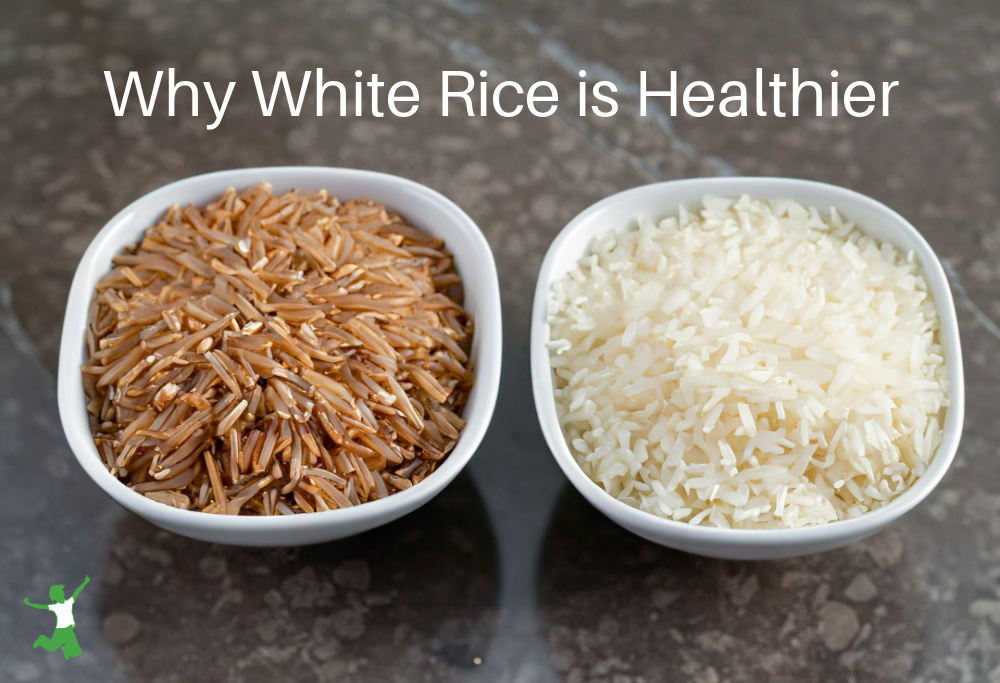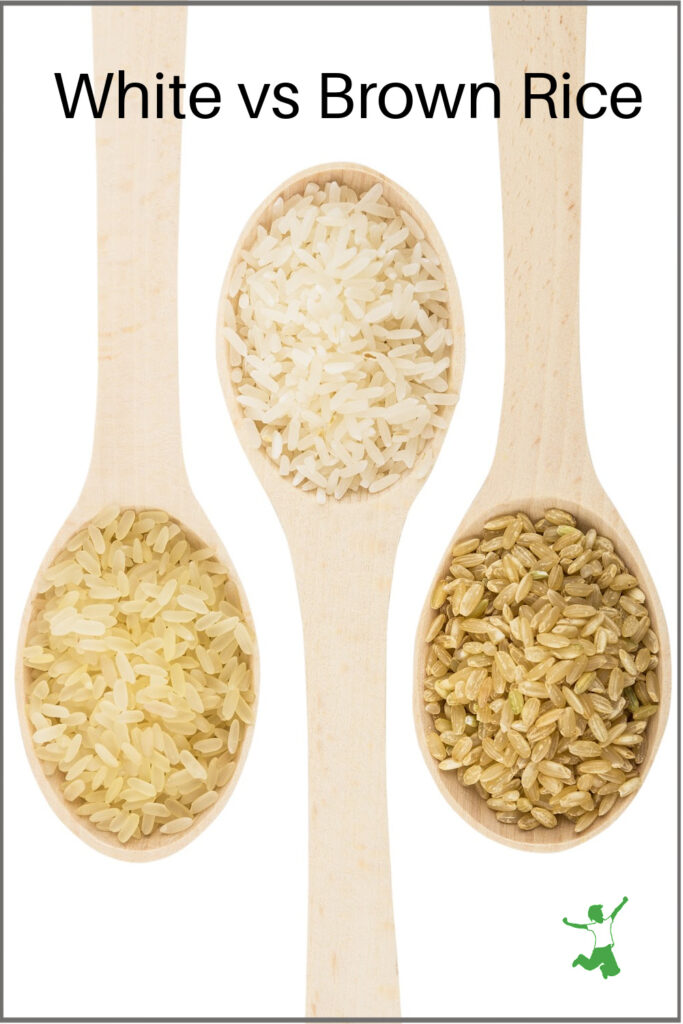The reasons white rice is healthier than brown rice as determined by research as well as which type traditional societies preferred consuming.

My article and video on healthy Chinese food drew some comments from readers who questioned my choice of rice.
Why was I using white rice vs brown? Isn’t brown rice the healthier choice, after all?
Ok, I’ll spill the beans, rice. Here are my reasons …
The truth is, neither my husband nor myself have ever enjoyed brown rice (although we love the nutty flavor and digestibility of wild rice).
Every time we eat brown, it just seems to not sit very well in our stomachs.
Even when it is sprouted or soaked before cooking, it, well, uh, sits like a brick for lack of a better word.
Why Some People Should Eat White Rice
White rice just seems to digest a whole lot better for us. That to me was reason enough to choose it over the brown rice.
We were also advised by an Ayurvedic MD back in the 1990s to stick with white basmati rice. This recommendation clinched the decision.
You are what you digest, after all – not necessarily what you eat!
End of story? Well, not quite.
Rice Fiber in Brown Harms a Compromised Gut
A few years back at the annual Wise Traditions Conference, I became familiar with a compelling book called Fiber Menace.
The author writes extensively about the dangers of a high-fiber diet as it pertains to a menu loaded with whole grains as pushed by the misguided Food Pyramid.
In other words, folks who eat a bowl of All Bran every morning to keep the bathroom visits regular are unknowingly ripping their insides to shreds.
The basic premise of Fiber Menace is that grain fiber plays a leading role in many gut-related ailments including colon cancer.
When I first learned of this information, my preference for white rice over brown rice started to make more sense.
Perhaps the brown rice didn’t digest that well because of all that fiber?
Chalk one up for the white rice.
White Rice Far Lower in Phytic Acid
A second piece of information came from author Ramiel Nagel.
In his book, Cure Tooth Decay, he writes about the devastating effects of phytic acid in the diet. Phytic acid is a very powerful antinutrient and blocker of mineral absorption in the gut.
Mr. Nagel identifies brown rice as very high in phytic acid.
What’s more, soaking brown rice does not reduce phytic acid by much at all!
Polished Rice is the Ancestral Form
Ramiel also maintains that the traditional method for preparing brown rice is never to eat it whole (with only the husk removed).
Rather, ancestral societies pounded brown rice in a mortar and pestle to polish it by removing the outer bran layer. This is the primary source of the phytic acid.
Nagel goes on to point out that experiments have shown that the milled and polished rice that results from this pounding process, has the highest mineral absorption.
In short, mineral absorption from whole brown rice is much less than white polished rice. This is because the phytic acid in the bran which is not reduced much by soaking, greatly interferes with the absorption process.
What About Arsenic?
A big issue with arsenic contamination in rice has emerged in recent years. Some folks have responded by no longer eating rice at all.
This is an overreaction, in my view.
Clean rice is definitely available if you know what to look for.
This article on how to avoid arsenic in rice details what to do. While soaking brown rice barely moves the needle on phytic acid, soaking white rice before cooking removes nearly all the arsenic!
Another option is to parboil white rice before using fresh water for a full cook if you don’t have time to soak.
Is White Rice Better Than Brown?
So it seems that brown rice is not necessarily a healthier choice than milled white rice.
Black or red rice would fall into the same category.
Obviously, whether you choose one or the other is a personal preference, but I hope this information helps you sort through the decision with a bit more clarity.
As for me and my family, we will be sticking with white basmati and jasmine rice (white basmati rice is more nutritious than plain white rice).
I currently buy this brand of rice in 25-pound bags as the most economical and high-quality choice.
Observation clued me in many years ago that brown rice was not something that was sitting well in my stomach or my husband’s.
As the years go by, more research is coming forth to indicate that this decision was the right way to go after all.
Do you eat white rice or brown rice in your home? Why or why not?

References
(1) Fiber Menace
(2) Living with Phytic Acid
More Information
Macrobiotic Diet and Extreme Vitamin D Deficiency
Tiny Teff Grains Deliver Big on Nutrition
How to Make Perfect Yellow Rice (Arroz Amarillo)
Millet: Healthy or Not?
Do Whole Grains Cause Cavities?








I just recently read an article somewhere which said not to eat white rice (or use rice cereal for babies) because it spikes insulin levels. Yes? No? Maybe?
Hi D, if one has blood sugar issues, the white rice (or even brown rice for that matter as brown rice or any grains spike insulin also) should be consumed within the context of a high fat sauce such as in Asia where rich peanut sauces are made with whole coconut milk for example. This levels out any potential insulin spike quite well.
I have been trying, to varying degrees of success, to eat grain free for years. As family economics wax and wain we sometimes are eating some grains. Having spent some time living in the hippie, vegetarian world I am no stranger to brown rice. But as you say, It just doesn’t sit right in the stomach. Maybe things that our bodies can’t digest are should not be eaten.
Depends on what I’m eating with it. I tend to eat low carb, but when I have rice with Chinese food, or Thai food, I go with brown. More flavor. With Indian I do white basmati. With Japanese, I do white sticky rice (although I prefer to get just sashimi). At home I have a mixed rice blend, which also has wild rice (not technically a true rice). Covers all the bases.
Such a great post–it’s time for the closet white rice lovers to come out!!! I have been known on cold, winter days to cook up a pot of white rice for myself and consume the whole thing, with lots of butter on top. It’s a real comfort. Just the other day my husband mentioned how nice it was to have white rice–which by the way seems to go much better with kim chee.
Sprouted brown rice is very good both taste wise, texture wise and in the way it digests, but it is expensive. I did try to sprout my own once and ended up with a pot of rice that to my husband and me “tasted like mash gone bad”. Bad taste, bad bad smell. Probably I did something wrong, but am not interested in trying it again.
Thanks for the encouragement to not stress over the white rice. It is after all , not the main part of a meal.
Keep up the good work!
We have been having a debate between brown rice and basmati for years!! I got on the brown rice bandwagon a while ago and never really noticed a problem with it. My partner, who is from East Africa insists on basmati and that it is very good for us.
Thank you for this. I have been feeling very guilty for feeding my family basmati rice, which I thought to be something which was not good for us. I will tell him that I am now much happier with basmati.
not sure on the white basmati being more nutritious than plain/short grain white rice.
I’ve not seen any data on it .. just was told this by an Ayurvedic doctor some years ago. I suppose if I was given a choice of short white rice (instead of basmati white) and brown rice, though, I would definitely go with the short white rice.
Hi Sarah,
I’m really enjoying your site (love the videos!) and it was nice to see another post advocating white rice … I’m also a fan of Perfect Health Diet which also recommends white rice over brown to avoid the toxins.
Haiga white rice is considered by some to be a middle ground where it is milled to remove the bran, but still retains nutrition from the germ.
I love the aroma and taste of basmati rice and I had saved this info regarding the Ayurveda perspective:
“According to Ayurveda, Basmati rice is the king of all rices. Basmati rice is saatvic or pure, it balances all three doshas, it is nourishing for the body tissues and it is easy to digest. Aged Basmati rice has an aroma and flavor arguably the best in the world.
The central concept of Ayurvedic medicine is the theory that health exists when there is a balance between three fundamental bodily humours or doshas called Vata, Pitta and Kapha.
VÄta or VÄyu (wind) is the impulse principle necessary to mobilize the function of the nervous system. It affects the windy humour, flatulence, gout, rheumatism, etc.
Pitta (bile) is the bilious humour, or that secreted between the stomach and bowels and flowing through the liver and permeating spleen, heart, eyes, and skin; its chief quality is heat. It is the energy principle which uses bile to direct digestion and hence metabolism into the venous system.
Kapha (phlegm) is the body fluid principle which relates to mucous, lubrication and the carrier of nutrients into the arterial system.”
Thanks,
Mark
Thank you Sarah for “giving me permission” to eat white rice again! No matter how I soaked brown, cooked it, etc. it just never tasted all that great and now I know why! I missed my white rice terribly and now I can eat it again without guilt! White basmati it is from now on! 🙂
Thanks Sarah, will try the Coconut flour for sure, and I also love the Coconut oil.. ya, and up till now it was dont eat bacon, dont eat butter and dont eat this or that and eat lots of grains. well until I started reading these posts , which really changed my thinking on eating. but with moderation..
Really appreciate the Healthy Home Economist….